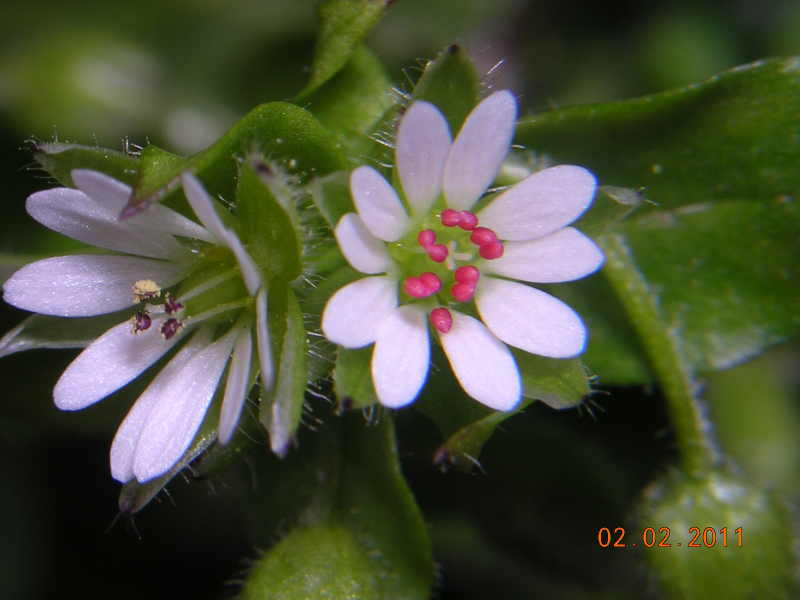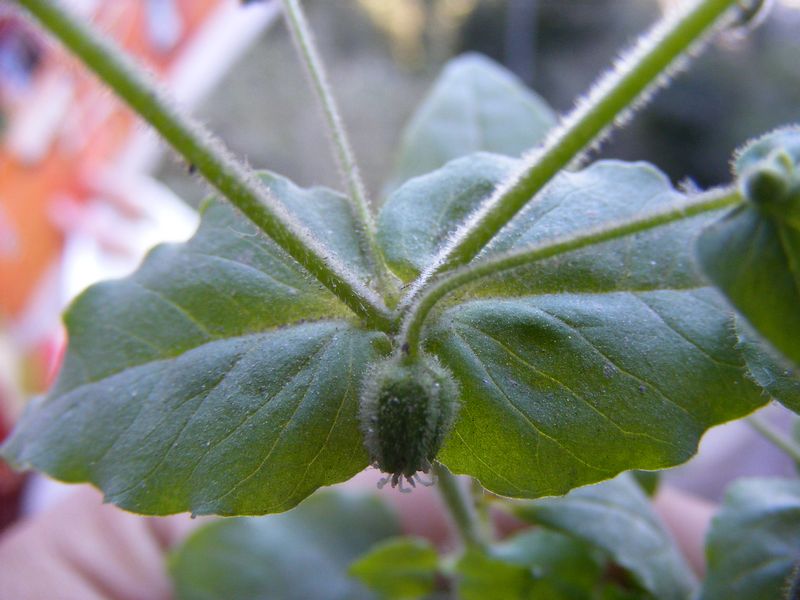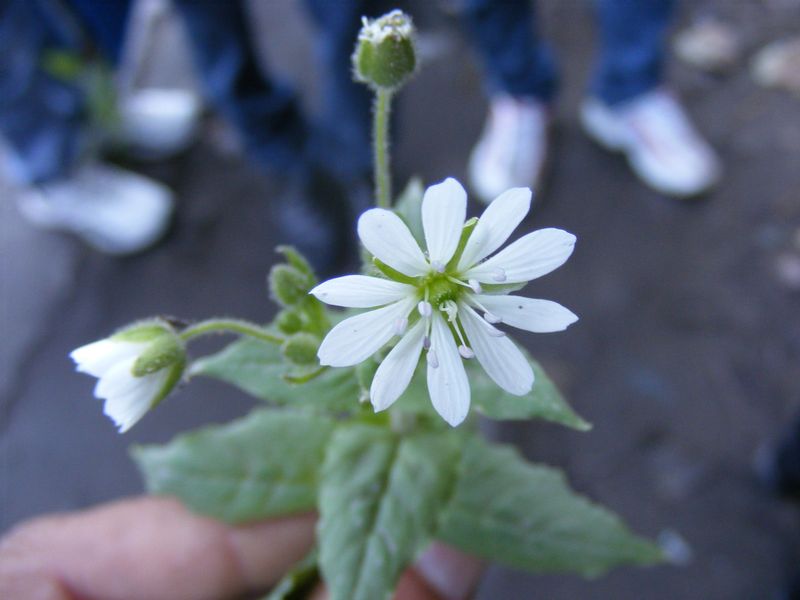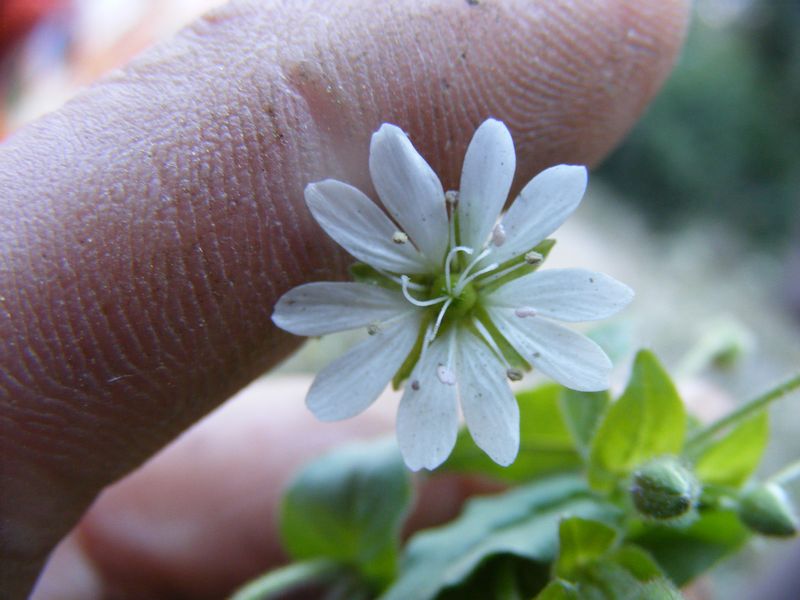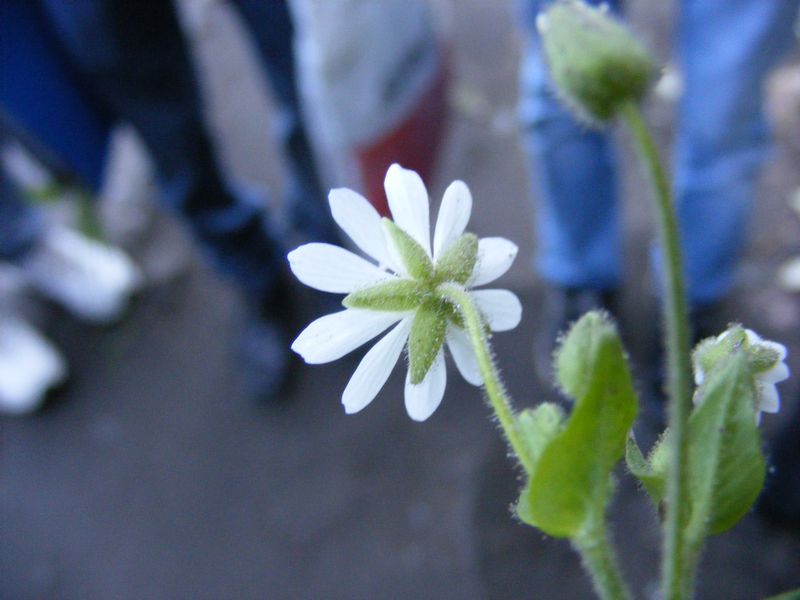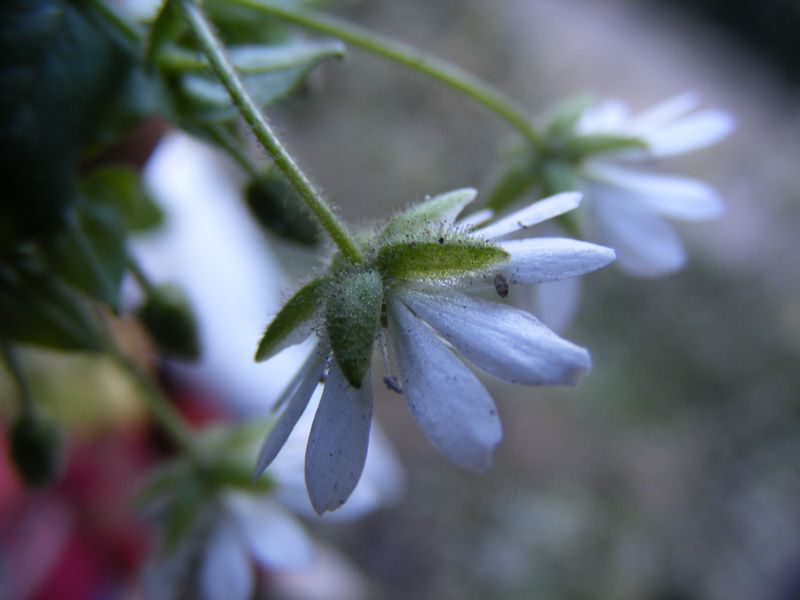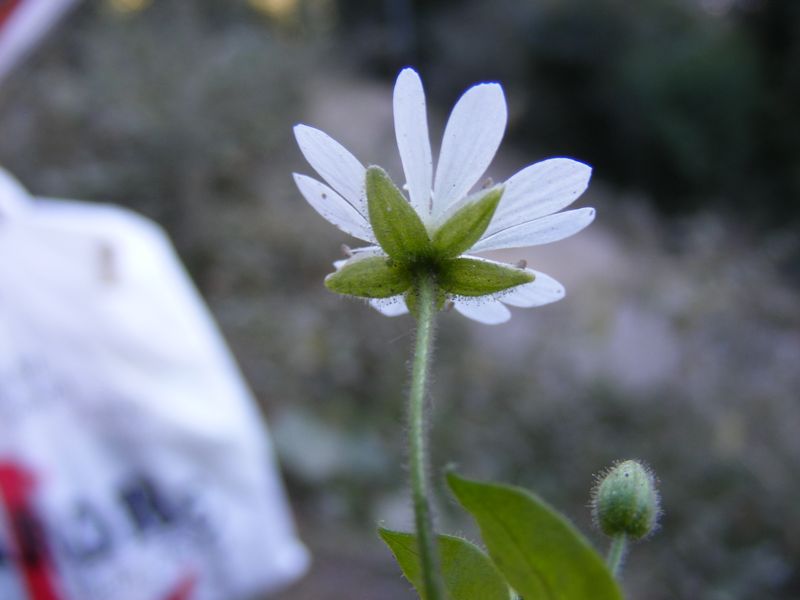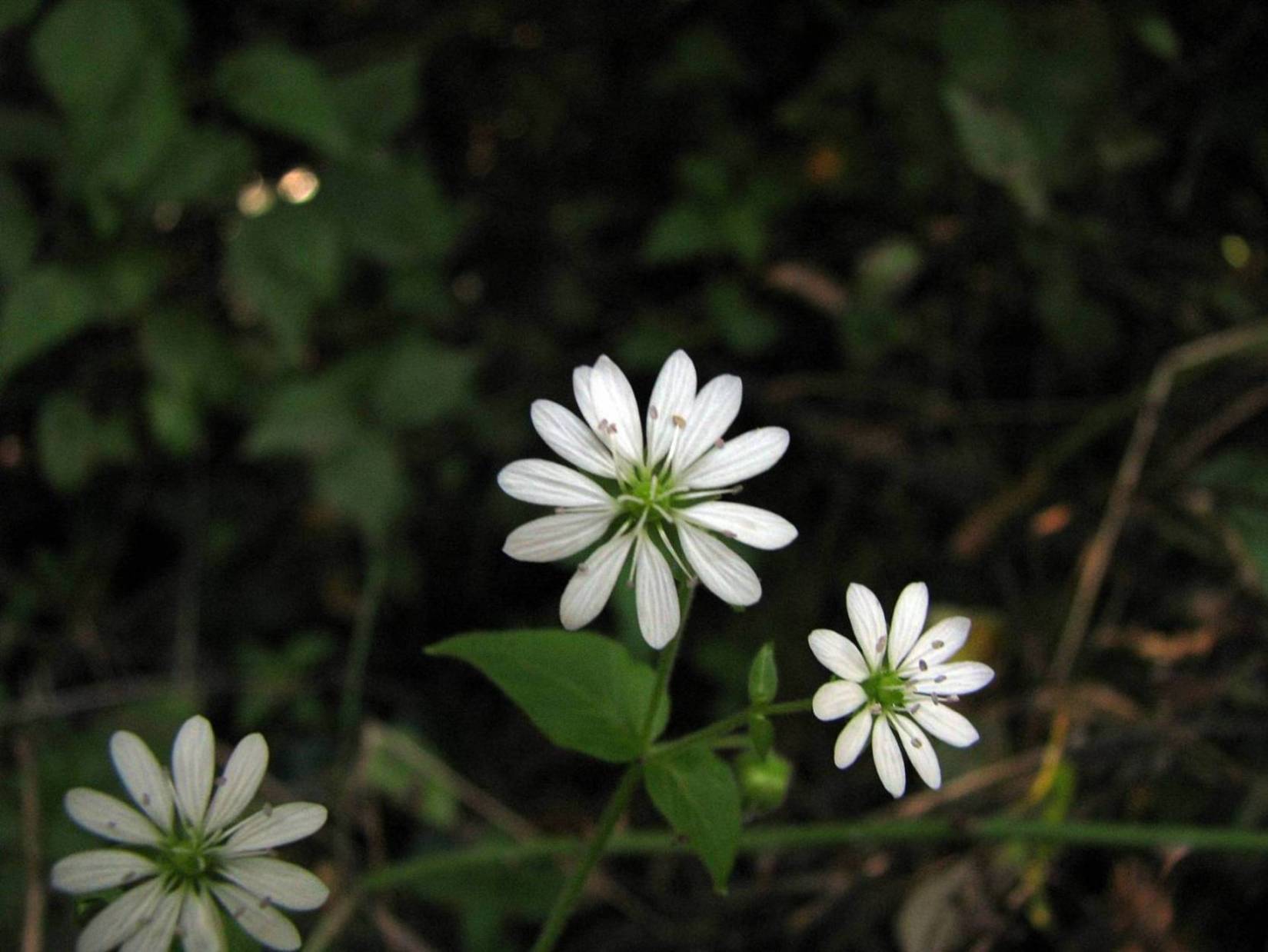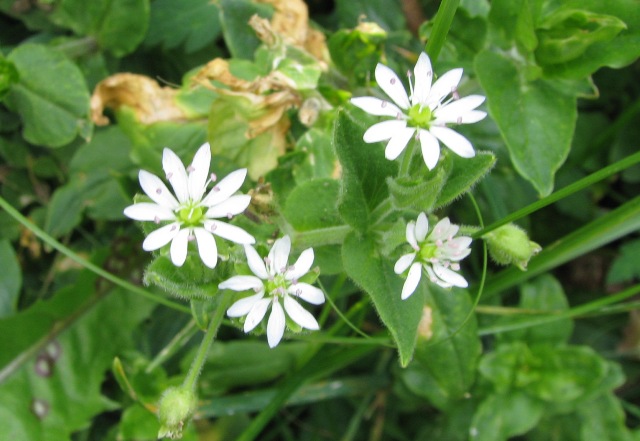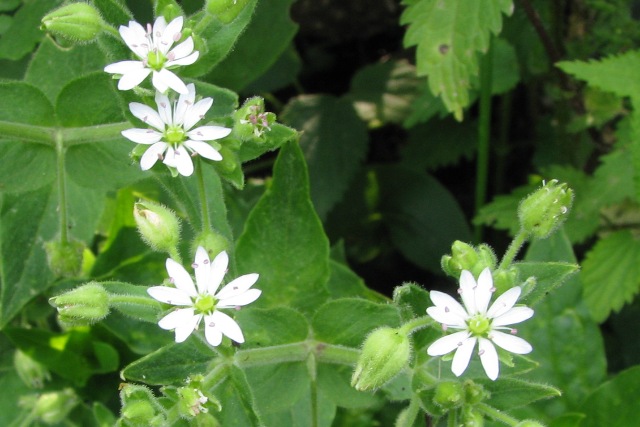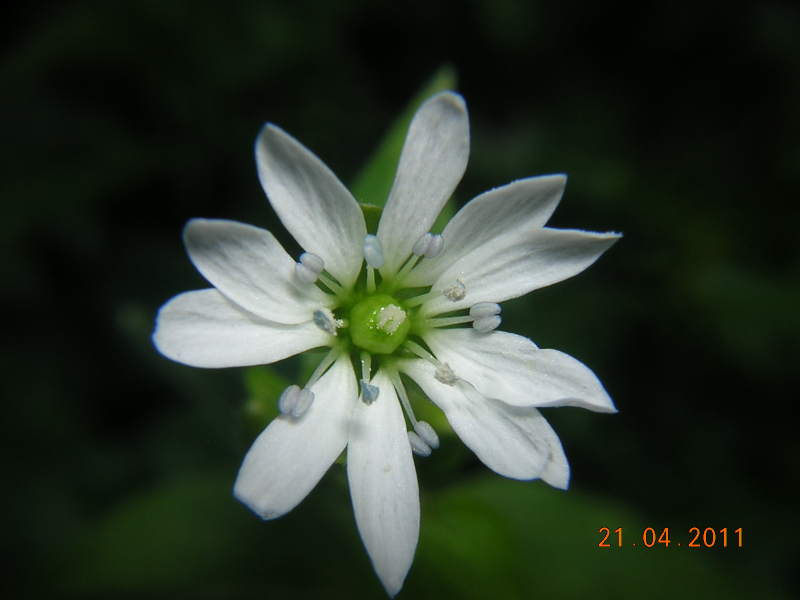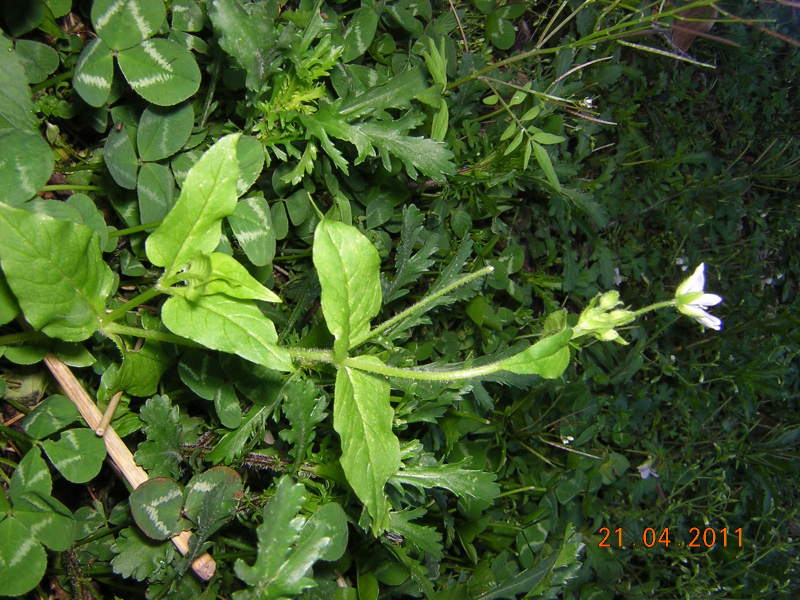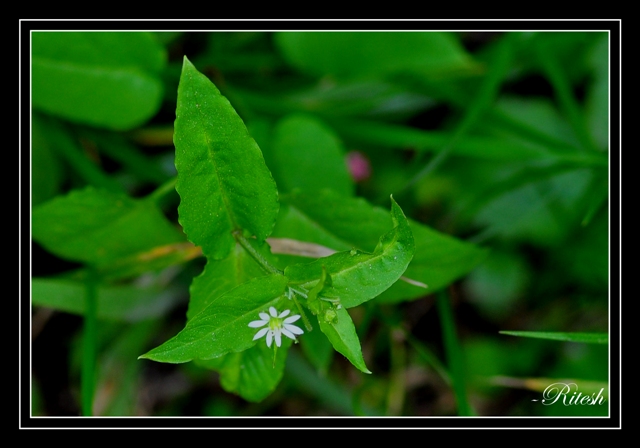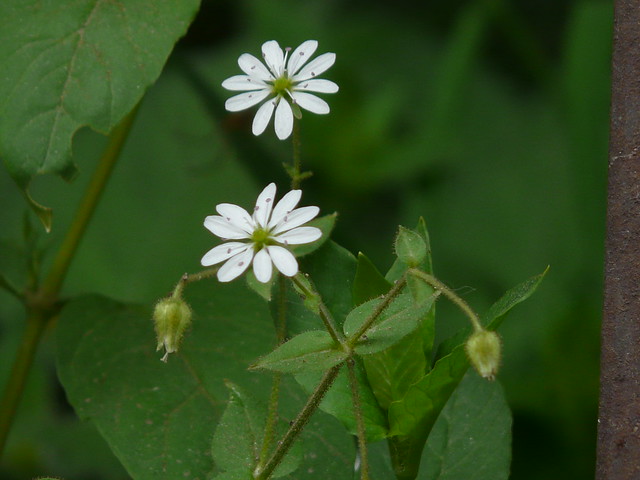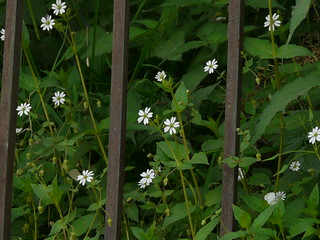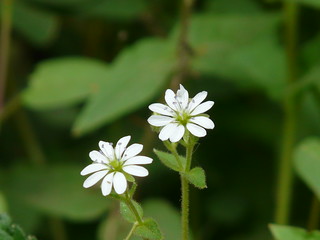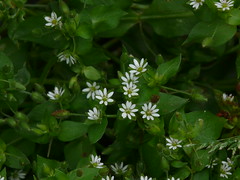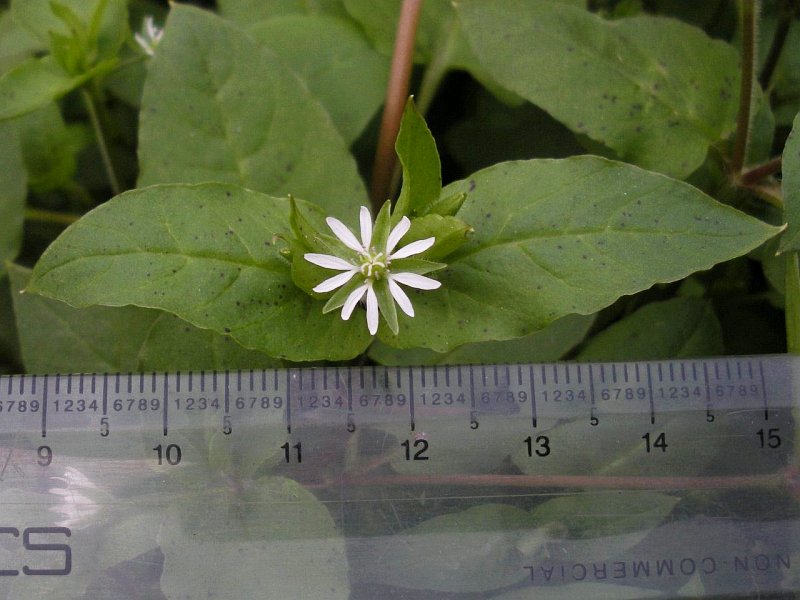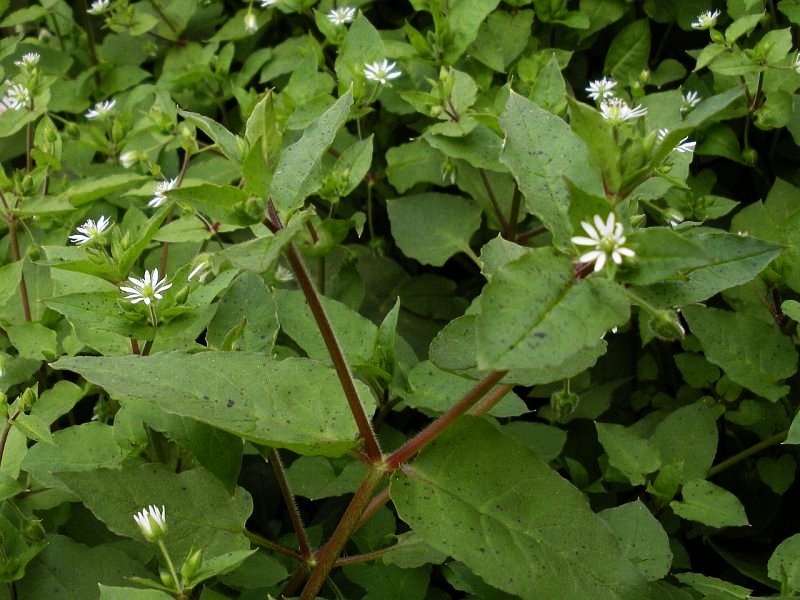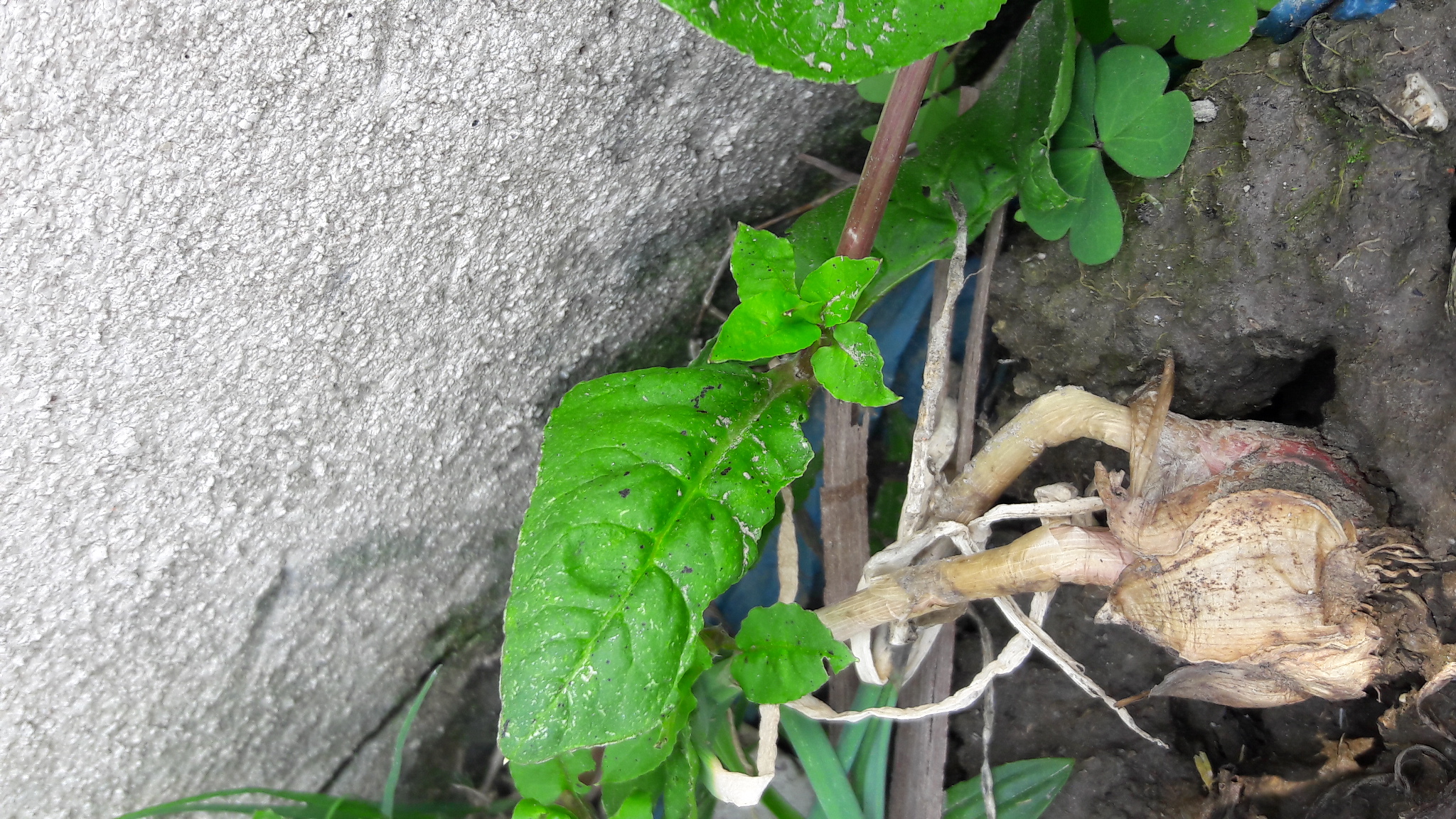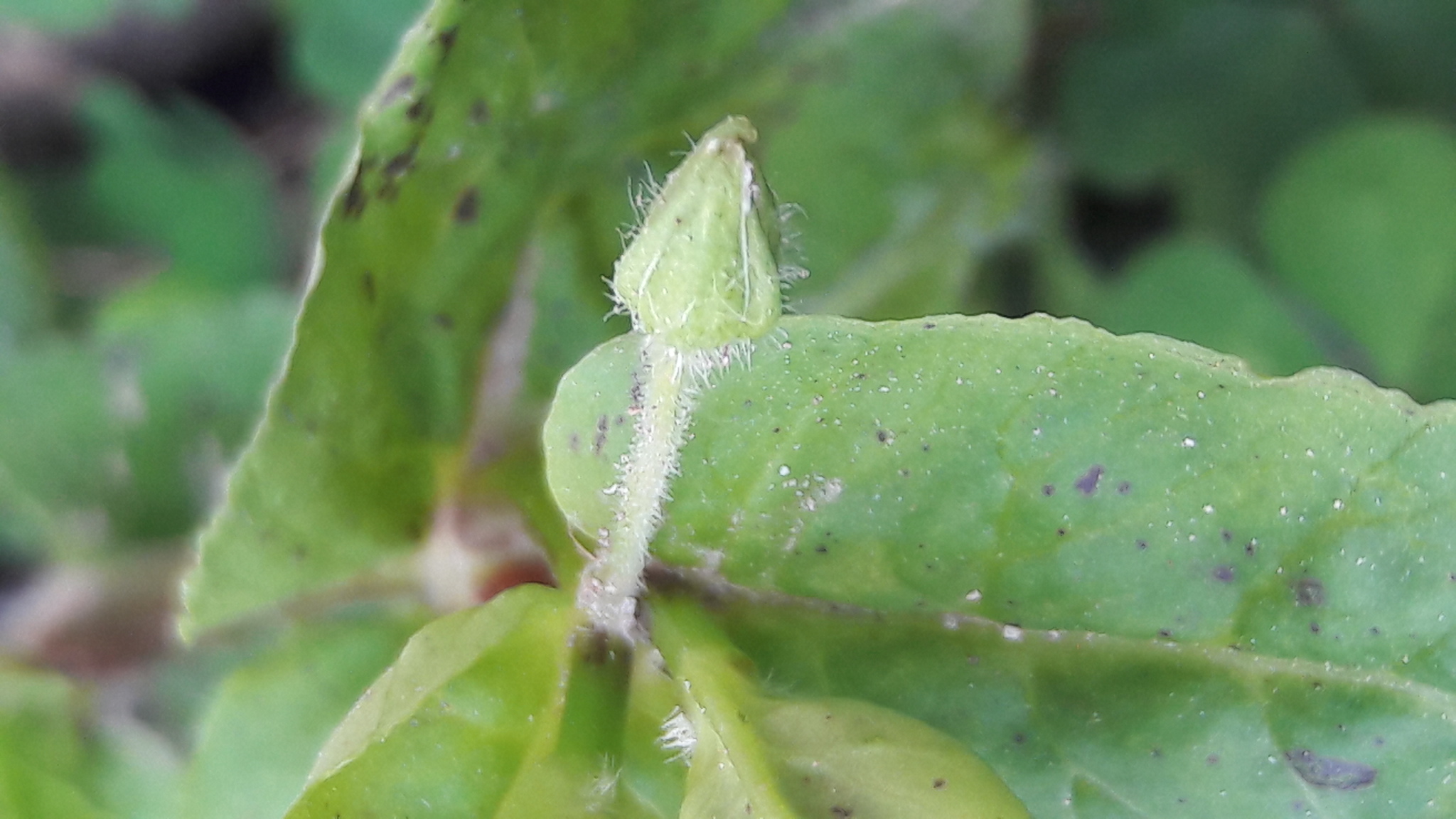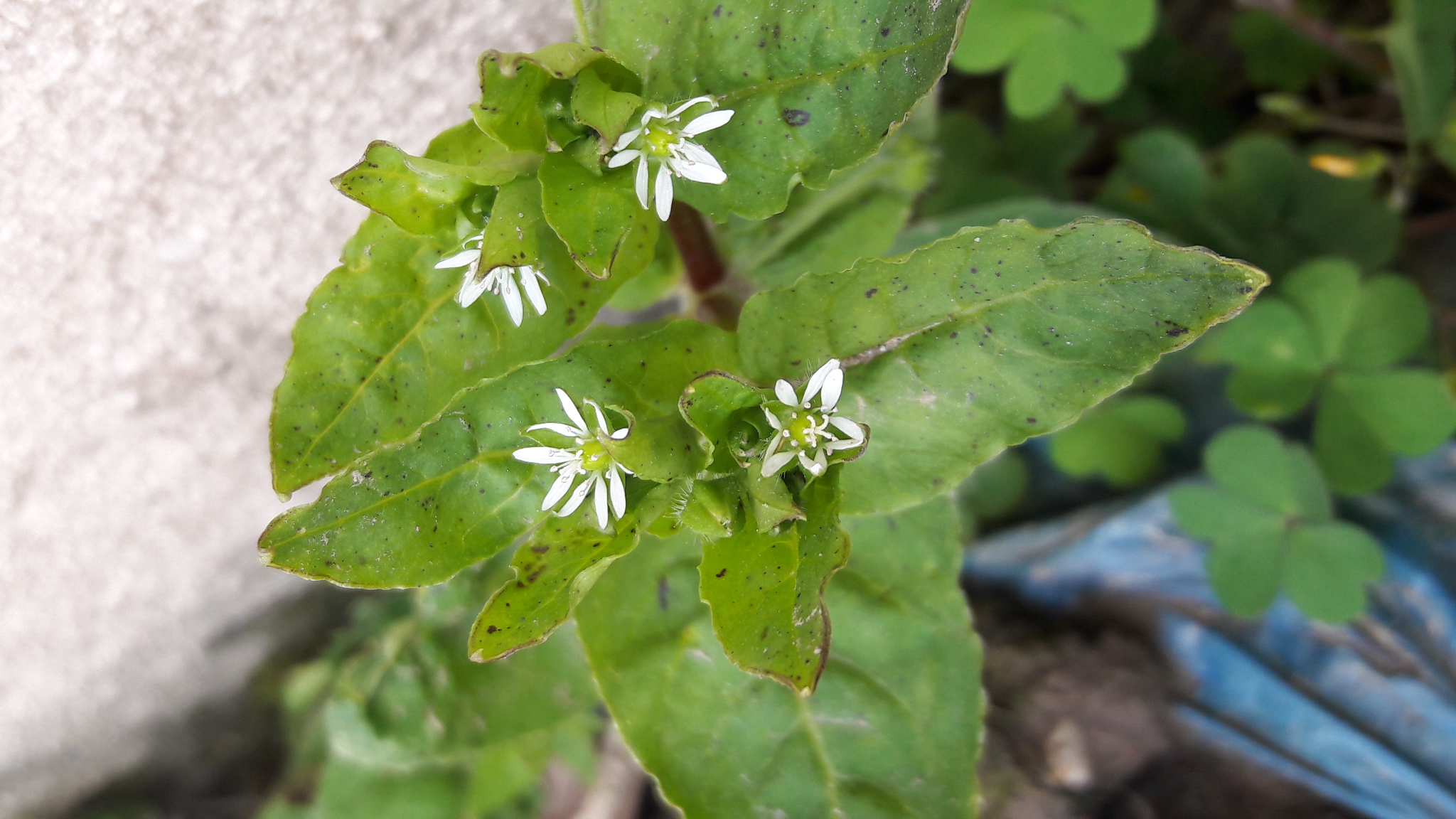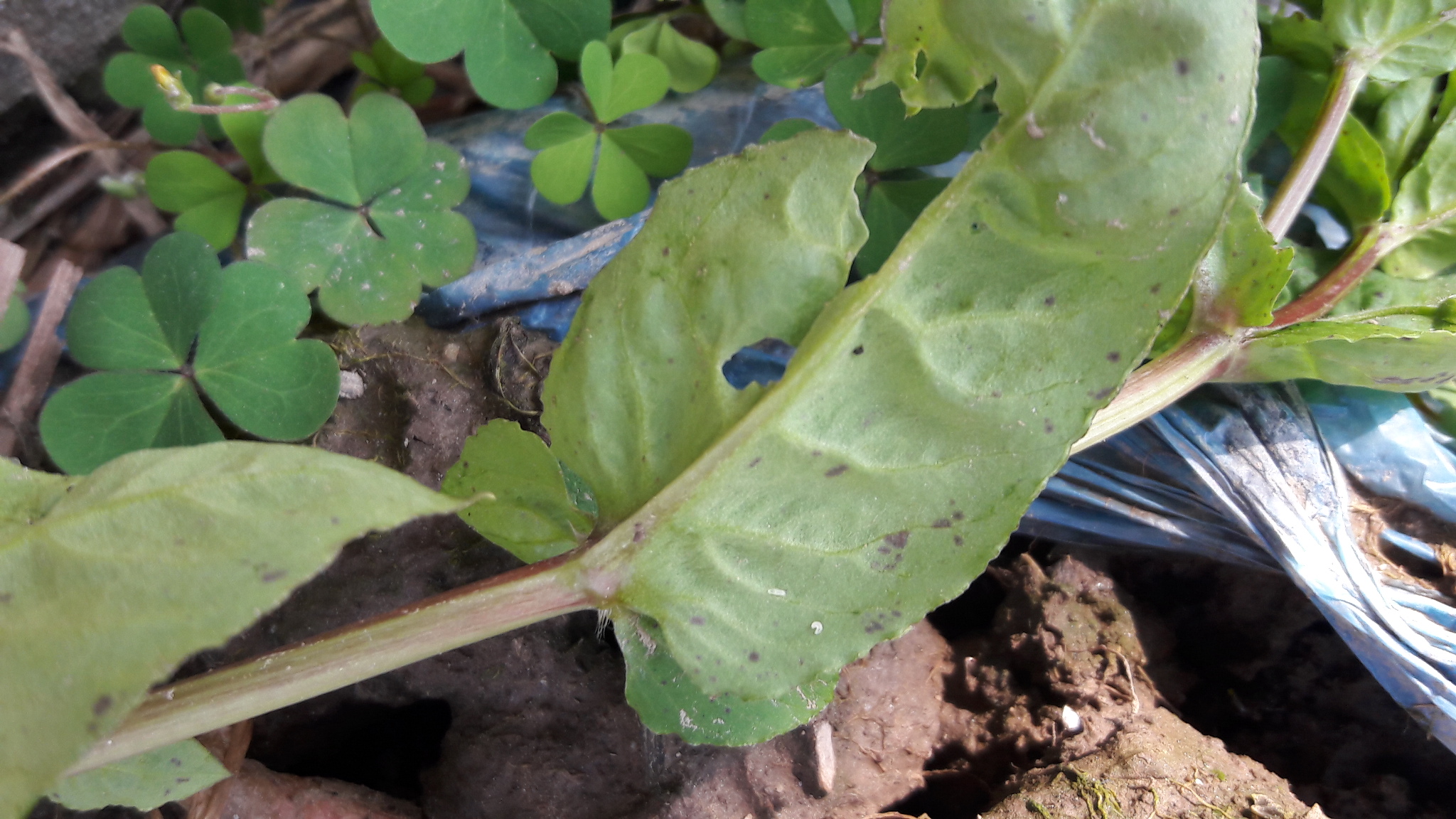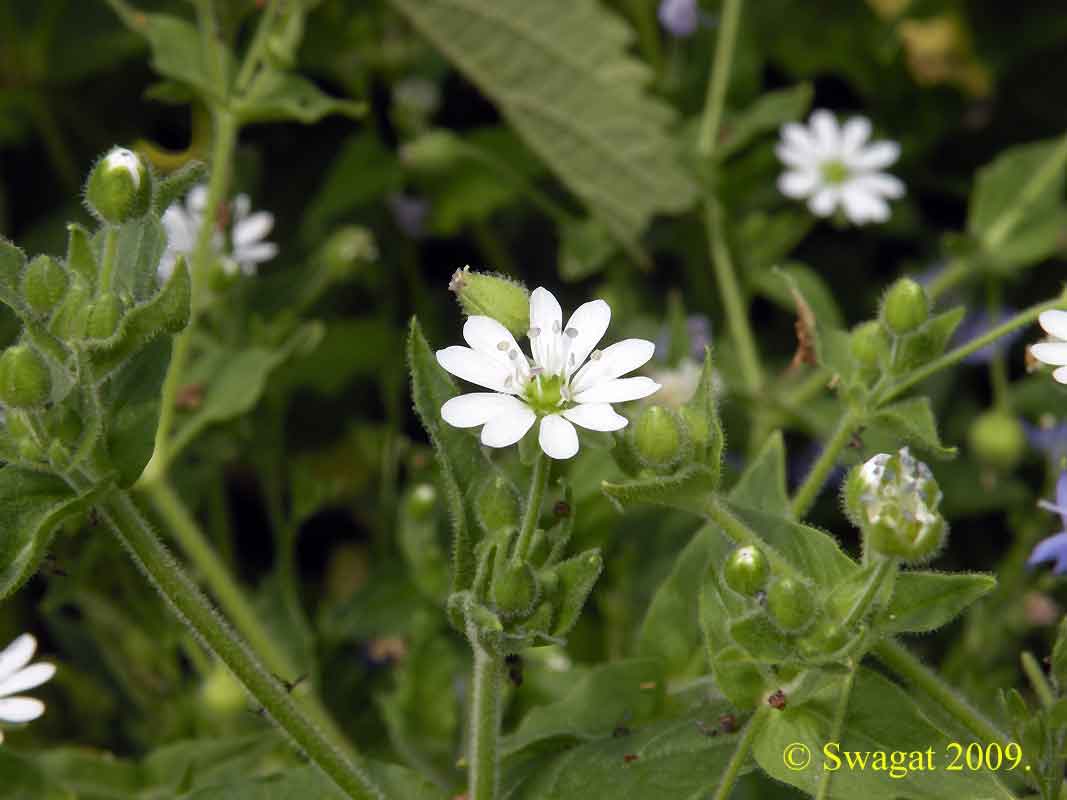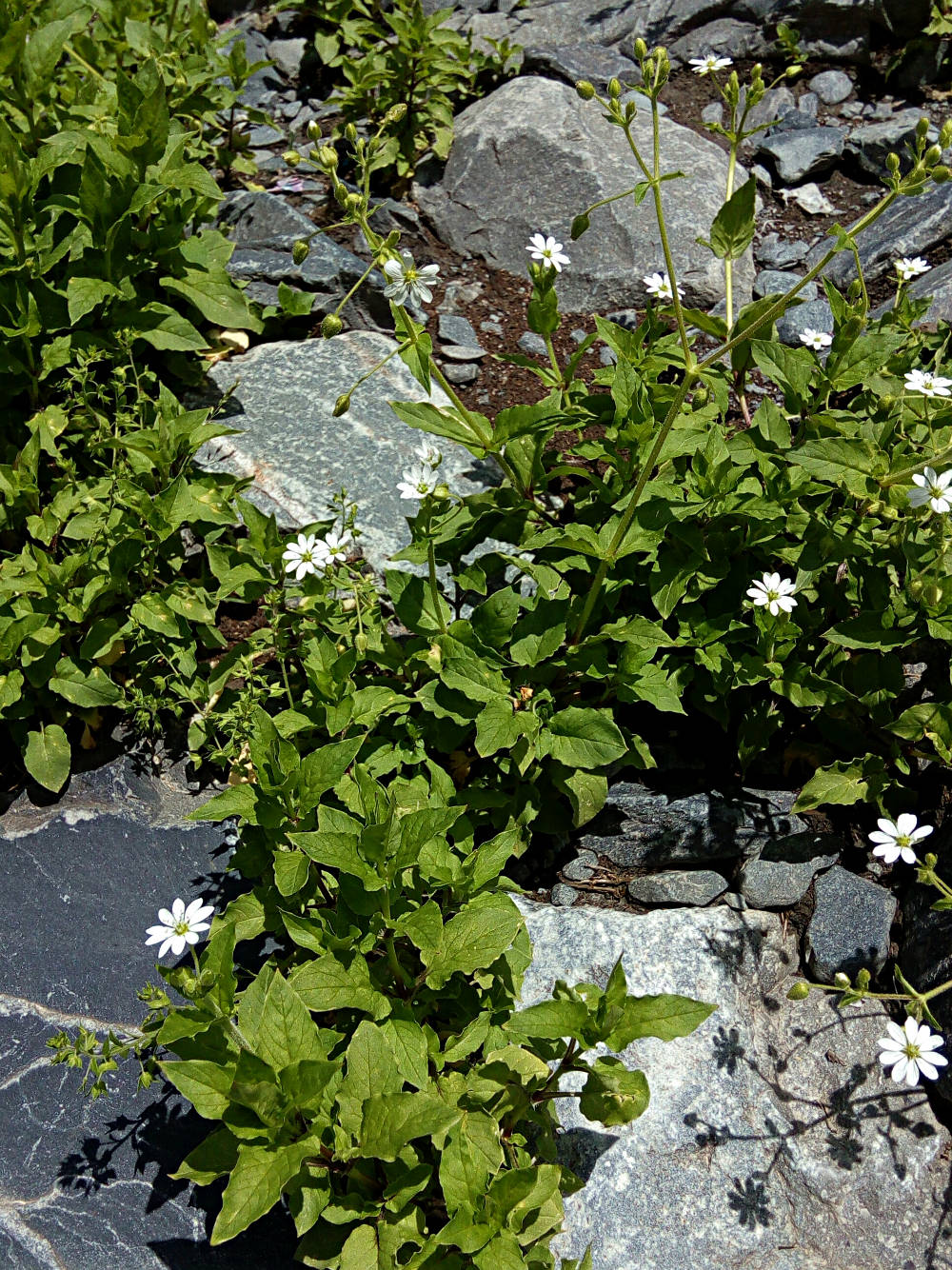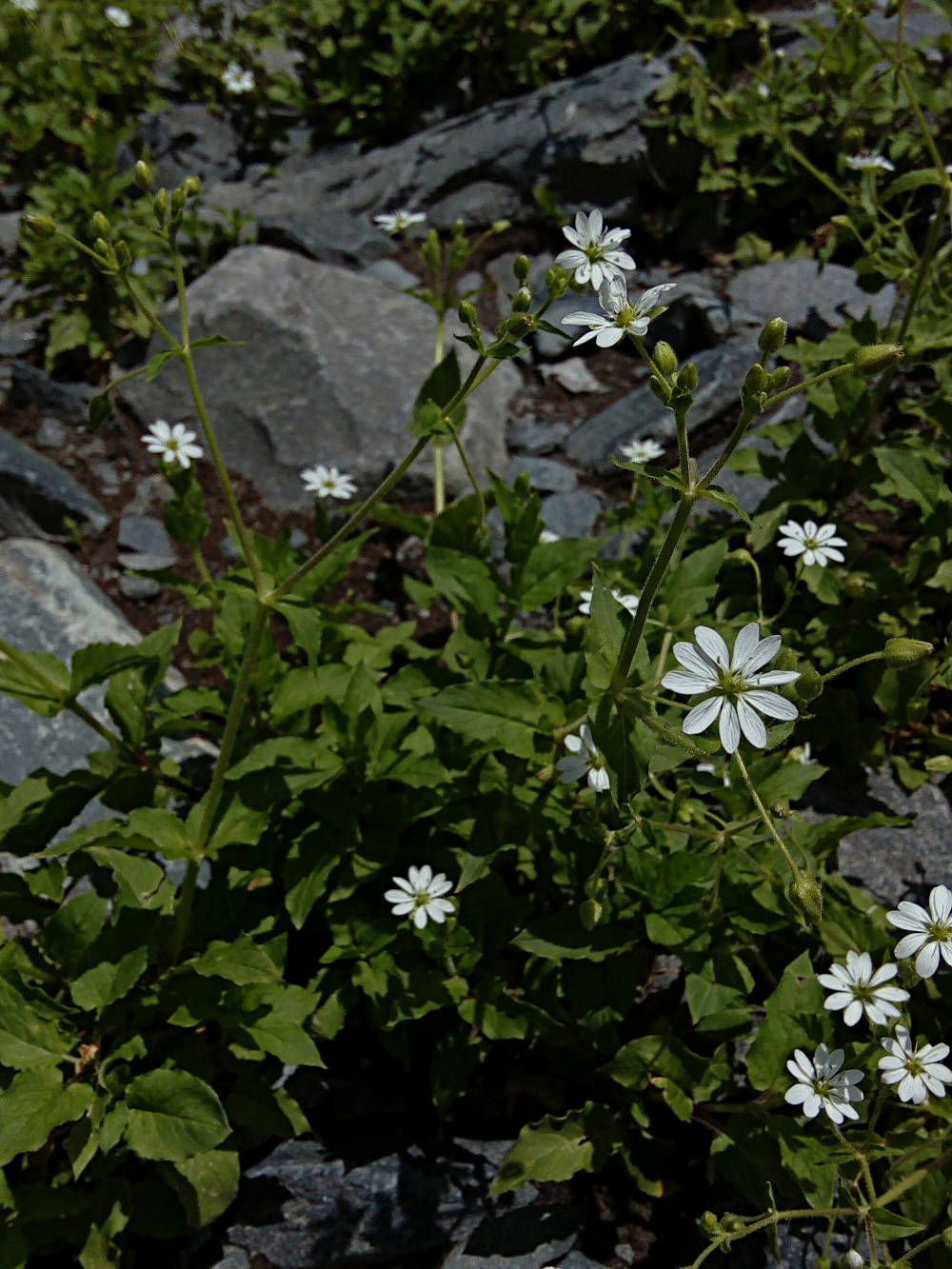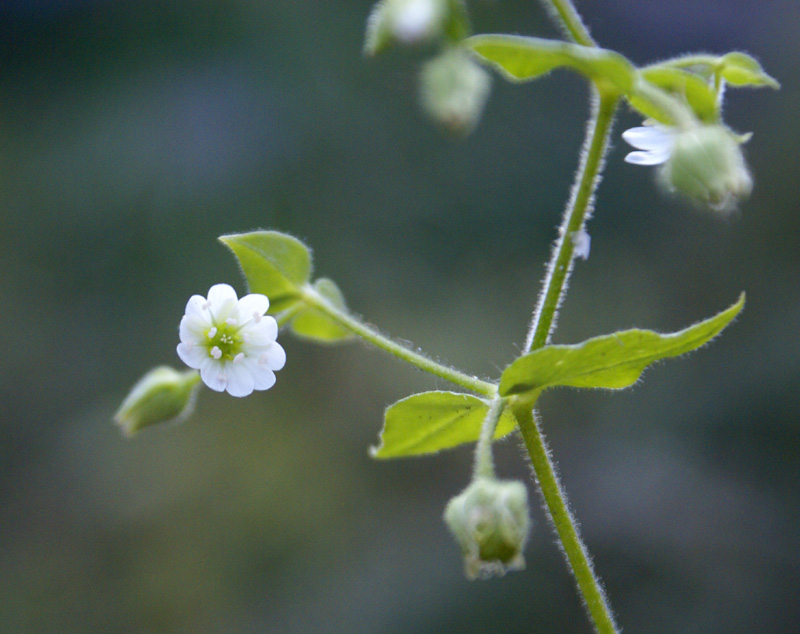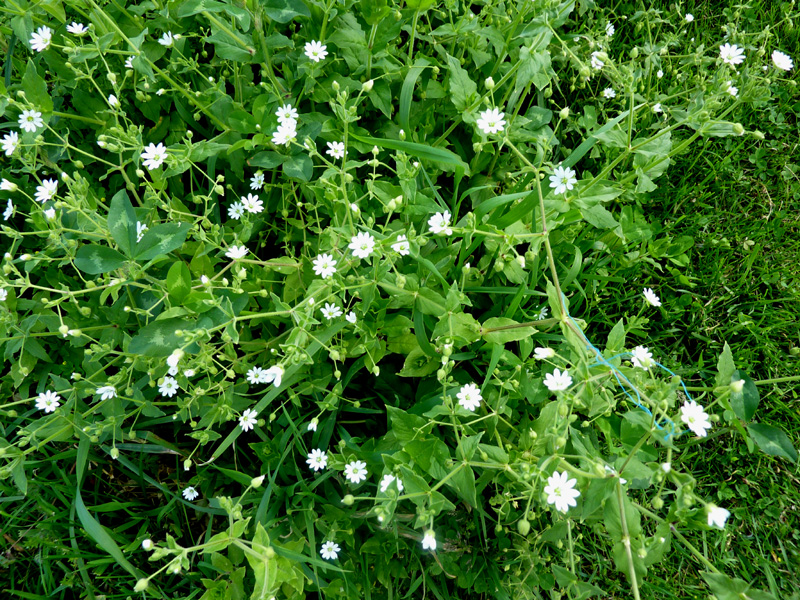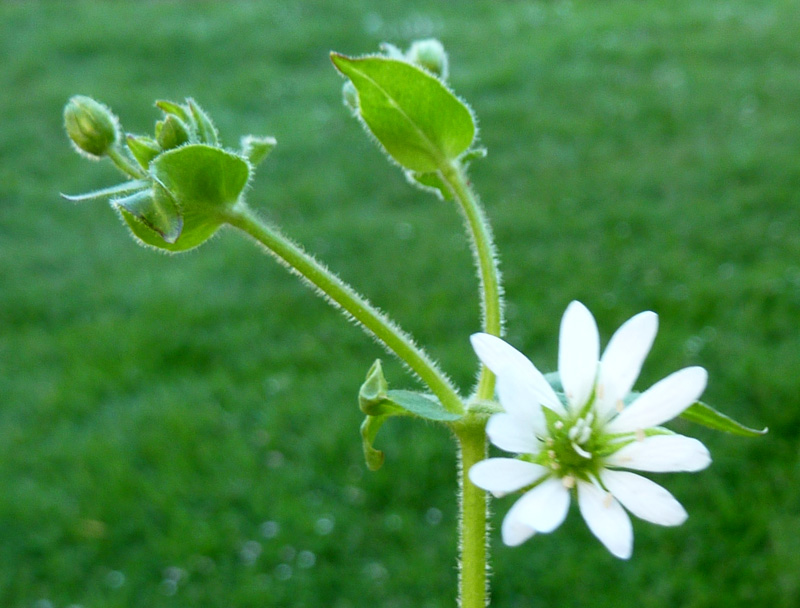|
Stellaria aquatica (L.) Scop., Fl. Carniol. ed. 2, 1: 319 1771. (syn: Alsine aquatica (L.) Britton; Alsine uliginosa Vill.; Cerastium aquaticum L.; Cerastium aquaticum (L.) Fr.; Cerastium deflexum Ser.; Cerastium maximum Gilib. ; Cerastium petiolare Hance; Cerastium scandens Lej.; Larbrea aquatica (L.) Ser.; Malachium aquaticum (L.) Fr.; Malachium calycinum Willk.; Myosanthus aquaticus (L.) Desv.; Myosoton aquaticum (L.) Moench);
.
Water star-wort, Water chickweed, Giant chickweed;
.
Decumbent or ascending perennial herb often reaching 1 m when getting support in wet situations; leaves opposite, lower petiolate, upper sessile, ovate, 2-6 cm long, base rounded or cordate, margin slightly undulate; flowers white 8-12 mm across, in few-flowered dichasial cymes, on slender pedicels; sepals oblong-lanceolate, 4-5 mm long in flower, up to 7 mm in fruit, glandular-pubescent outside, margin scarious; petals up to one and half times as long as calyx, deeply bilobed; capsule ovoid, 7-9 mm long.
.
Myosoton aquaticum (L.) Moench (=Stellaria aquatica (L.) Scop. can be easily overlooked among the population of Stellaria media (L.) Villars, as both have minute white flowers with 5 deeply bipartite petals. To distinguish them one needs a hand lens to count styles; 3 in S. media and 5 in M. aquaticum. Additionally, capsules are 6-valved with entire apices in S. media but M.aquaticum has 5 valves in capsule with lobes bifid at apices. Capsules are broader and larger in M. aquaticum but with smaller seeds.
.
stellaria id al021018: – You will have to wait till you have well focussed flowers where styles can be counted. Till then it is Myosoton aquaticum Wild flower for ID (30/06/2011 -NSJ-01): Location – Pahalgam Hills, Kashmir Wild Flowers for ID : Gulmarg : 201011 : AK-3:
Tiny White flowers seen at Gulmarg on the 11th of Sept,11. Small plants like herbs growing wild. Flowers about 1 cm in size. Can they be Cerastium species? C fontanum in FOI seems to resemble my picture. Please validate. Yes Sir, Myosotos aquaticum I have also found these flowers at Gulmarg in June this year. One photo is attached herewith. you copied my wrong spellings. actually it is my fault Stellaria Sp for ID?-221111-PKA1: Myosoton aquaticum Myosoton aquaticum from Paddar valley J&K: Bot. name: Myosoton aquaticum Family: Caryophyllaceae
Location: Paddar valley J&K
Altitude: 2100 meters
Date: 19th May 2012 Yes … Good photographs stellaria again… Please always upload with leaves to enable identification up to species level. The first is perhaps Stellaria media, second possibly Cerastium Thanks …, Here’s a photo of the leaves.. This is Cerastium fontanum (syn: C. vulgatum) Thank you …, You’re a walking encyclopedia… :)) Not able to count number of styles but from leaves it looks like Myosoton aquaticum (syn: Stellaria aquatica) which differs from Stellaria in having 5 styles. Caryophyllaceae Week: Cerastium sp. from Dalhousie: Again Myosoton aquaticum . Caryophyllaceae Week: Myosoton aquaticum from Kashmir and Manali: Syn: Cerastium aquaticum (L.) Fries; Stellaria aquatica Scop.
Decumbent or ascending perennial herb often reaching 1 m when getting support in wet situations; leaves opposite, lower petiolate, upper sessile, ovate, 2-6 cm long, base rounded or cordate, margin slightly undulate; flowers white 8-12 mm across, in few-flowered dichasial cymes, on slender pedicels; sepals oblong-lanceolate, 4-5 mm long in flower, up to 7 mm in fruit, glandular-pubescent outside, margin scarious; petals up to one and half times as long as calyx, deeply bilobed; capsule ovoid, 7-9 mm long.
Photographed from Kashmir and Manali
Caryophyllacceae week: For id from Manali..Cerastium sp.?: Myosoton aquaticum
Caryophyllaceae Week: :Myosoton aquaticum from Dachigam Srinagar -PKA16: Seen this herb at “Dachigam, Srinagar”. Mumbai: Myosoton aquaticum Date/Time: 24-09-2011 / 03:55PM Habitat: Wild Plant habit Herb. Yes … Yes … All your Caryophyllaceae posts are very good. The flowers in top or front view look so beautiful with nice radial symmetry. Amarnath Yatra: Cerastium fontanum ?? (NSJ-02 31/08/2013) : Attachments (2). 3 posts by 3 authors. Panipat 2014: Cerastium for id :: NS March 08 : Attachments (6). 3 posts by 2 authors. I think you missed it … HP, Oct 2014 :: Requesting ID validation – Stellaria :: ARKDEC-43 : 6 posts by 4 authors. Attachments (4).
Requesting to please validate ID of this beautiful flower captured near Manali, HP in October 2014.
I hope this is Stellaria media (based on FoI pics). efi page on Stellaria media In Stellaria media, the sepals are longer than petals; whereas in this case, petals are longer than sepals. Can probably be S. latifolia. Myosoton aquaticum I hope Thanks … for the ID… I went through the earlier posts on efi for Myosoton aquaticum… Date: 6th August 2011
Plant location: Paddar valley district Kishtwar J&K.
Altitude: 2160 meters asl
GPS: 33.33 N and 76.23 E
Plant habit/habitat: Wild herb
Plant height: 1-2 feets Petals are slightly confusing, but looks like Myosoton aquaticum. Please check whether petals are deeply lobed or not and number of styles. photograph of mature fruit should help. And …, it is not a shrub, rather soft herb. I am really sorry and I apology for writing Shrub in Subject line for identification of a herb. Actually I was thinking of uploading a shrub but at last moment I uploaded the herb and missed to change shrub in subject. Sir the the petals seems to be deeply lobed and the number of styles is 10 in this flower. styles can’t be 10. They have to be 3 or 5, see above the ovary not surrounding (stamens) it.
Looking now at petals it may be Cerastium. Myosoton aquaticum is another plant I have no doubt walked past in the Himalaya without paying any attention to. Stewart records it in N.Pakistan & Kashmir at 1000-2400m (extending this to 3000m in his personally annotated final copy of his ‘Annotated Catalogue of the Vascular Plants of Pakistan & Kashmir) with records from Tangmarg. Hooker named it Stellaria aquatica. Collet in ‘Flora Simlensis’ has it under Stellaria aquatica (as one would expect for a publication +/- a century old, he mostly followed Hooker’s ‘Flora of British India’ for nomenclature; he found it at Shimla & Narkunda, in wet places and along streams. It is a native of the UK, known as ‘Water Chickweed’. In N.America, it has become something of an invasive weed. There are good illustrations at: illinoise Wild flowers and https://en.wikipedia.org/wiki/Myosoton_aquaticum
kalatope id al290411:
The forest is full of various small flowers.. this is one of them.. to my untrained eyes they all looked the same and when I look again they seem different… anyhow here’s this.. Location Kalatope, Chamba
Altitude 2100 mts Habit herb Habitat wild Height 3-4 inches You seem to be missing vital information. Photographs can be misleading, especially close ups unless you mention the size (leaves, flowers–length and dia), habitat, size of the plant and a few other things. Can we have another close up. The styles are difficult to count in this flower. I do realise the problem … the problem is that most of the time when I have taken these photos.. I am usually on the move in the field… working in the villages.. and often there is not much time I can spare for the flowers except quickly snap off a few photographs.. Could be Myosoton aquaticum but number of styles (5) needs to be verified. Myosoton aquaticum (L.) Moench as per images herein. Myosoton aquaticum (L.) Moench (accepted name) ??? : 4 posts by 2 authors. Attachments (16) Location: Bojepokhari, Lalitpur, Nepal
Altitude: 4200 ft.
Date: 28 January 2017
Stellaria aquatica (L.) Scop. (synonym) ??
If correct ID flowering period is not matching. None of Stellera is found flowering in January according to FofN!
Myosoton aquaticum from Pantnagar, Uttarakhand_DSR_Feb.2017 : 2 posts by 2 authors. Attachments (5)
Myosoton aquaticum (L.) Moench (=Stellaria aquatica (L.) Scop. can be easily overlooked among the population of Stellaria media (L.) Villars, as both have minute white flowers with 5 deeply bipartite petals. To distinguish them one needs a hand lens to count styles; 3 in S. media and 5 in M. aquaticum. Additionally, capsules are 6-valved with entire apices in S. media but M.aquaticum has 5 valves in capsule with lobes bifid at apices. Capsules are broader and larger in M. aquaticum but with smaller seeds.
BSD (Herbarium of Botanical Survey of India, Dehradun) have no specimen collected from Uttarakhand. Wonderfully explained, … Weeds are beautiful_Stellaria media_RKC_05_111011:
Stellaria media (L.) Vill. for you. Family: Caryophyllaceae To me styles appear to be five, it may be Stellaria aquatica as per keys & images herein. Also leave margins are undulate. Caryophyllaceae Week :: DV :: 03 JUN 08 – 0136 :: Stellaria media at Manali: stell-AR-ee-uh — stars, star-like … Dave’s Botanary
MEED-ee-uh — average, middle … Dave’s Botanary commonly known as: adder’s mouth, chick wittles, chickweed, passerina, satin-flower, starweed, starwort, stitchwort • Hindi: बुच बुचा buch-bucha • Manipuri: যেৰুম কৈৰুম yerum keirum Native to: Europe, n Africa, temperate Asia; widely naturalized References: Flowers of India • Wikipedia • NPGS / GRIN • PIER species info at Manali on 04 JUN 08 after posting having posted this plant photos, I searched through archive of eFI … there are lot of posts related to Stellaria ! and to me it is difficult to tally aspects of my plant. Apologies for having posted it with a confident ID. With so many species of Stellaria and even some other genera with look-alike aspects; I am not comfortable with my ID. Please validate the ID of the posted plant. Please allow a better view of flower to count number of flowers. A cropped photograph from original image. I think Stellaria media only, a more hairy form. As styles appear to be five, it may be Stellaria aquatica as per keys & images herein. Hooghly Today : Stellaria media (L.) Vill.? or Stellaria media var. media ?: The Plant List also lists Stellaria media var. media, one of its synonym is Stellaria monogyna D. Don.
But, neither GRIN nor The Plant List describes a plant (do they?).
FoP has Stellaria media (L.) Vill.
FoC has two varieties of Stellaria media (L.) Vill.
This species, a wild small decumbent herb, more or less a ft high differs in all of the above either in 1) flowering season, 2) number of styles, 3) number of stamens or in more than single feature.
But, this species conforms to Stellaria media L. of “Bengal Plants”, along with Stellaria media L. = Stellaria monogyna D. Don = Alsinella wallichiana Benth. of F. B. I. i. 230.
What will be its current accepted name? Stellaria media (L.) Vill. is based on Alsine media L., and S. monogyna is a synonym of of it It would be sufficient to list it as such unless we are also listing a variant also say for Stellaria media var. micrantha (Hayata) T. S. Liu & S. S. Yingvar. Now we would have two taxa, one the original typical plant which would get automatically named as Stellaria media (L.) Vill. var media (an autonym, as it is automatically created so no author name).
In a way when we are listing simply Stellaria media, it means we are referring Stellaria media var. media.
Now one of the blunders of The Plant List. It lists Stellaria media subsp. cupaniana (Jord. & Fourr.) Nyman; logically whenever such a subspecies name is created the original type should become Stellaria media subsp. media, and if the two varieties are to be retained they would have names as Stellaria media (L.) Vill. subsp. media var. media and Stellaria media (L.) Vill. subsp. media var. micrantha (Hayata) T. S. Liu & S. S. Yingvar.
But then perhaps no one associated with The Plant List knows these basics of Botanical nomenclature. Now, i think i can understand a bit how naming convention goes into plant taxonomy. I had no clear idea earlier.
Thank you very very much for explaining. As styles appear to be five, it may be Stellaria aquatica as per keys & images herein. Yes …, It is S. aquatica. Stellaria media at Sainj Ropa – GHNP – PKA94 : 1 post by 1 author. Attachments (3). As styles appear to be five, it may be Stellaria aquatica as per keys & images herein. Stellaria media (L.) Vill. ??? : 6 posts by 3 authors. Attachments (8)
Location: Ramkot, Kathmandu, Nepal
Date: 26 March 2017
Altitude: 4400 ft.
I think appears close to images at Stellaria media Myosoton aquaticum, now known as Stellaria aquatica (Caryophyllaceae) to me. % styles differentiate it from S. media.
Our S. media page need re-examination as some of the pics are of this (S.aquatica) species. Thanks, …, for pointing out. Thanks to all. Link Which one should be the accepted name ? https://www.catalogueoflife.org/data/taxon/45676
Stellaria aquatica (L.) Scop. POWO says about Myosoton aquaticum (L.) Moench: for ID 050609ET114 : 3 posts by 3 authors. Attachments (2)
I took this flower picture while trekking from 2100 metre level to Request for ID 090909 Dudh Pathri 3 : 12 posts by 5 authors. Attachments (1)
Photos taken at Dudh Pathri, Jammu & Kashmir. … most probably … Stellaria media (syn. Alsine media) It does look like a Stellaria species. However, a bit too hairy for You are worried about hairyness, plus I also am finding half or less divided petals (though one petals seems to be divided nearly to the base) negating Stellaria. I find at least one fruit suggesting apical teeth of Cerastium. …, do you have some other photographs for better decision. attaching one more photo… Attachments (1) I think Stellaria media only Let me say here why I think this is not Stellaria media. Stellaria lanata is one candidate I am looking at – unfortunately I am learning a lot from your keen observations.
I found one more photo but it is from totally different place…
It is not from Dudh Pathari,,,, It is photographed at ‘Aru’ ‘अडू’, Leader Vally लिडर व्हॅली, Jammu & Kashmir.
Date 05th August 2009.
Is it the same???
Attachments (1) It is Lidder valley, not Leader valley
I would say Stellaria media Herb for ID, Lower Manimahesh, Himachal Pradesh NAW- SEP17-17 : 3 posts by 3 authors. Attachments (3)
Kindly identify this herb with white flowers photographed along the trail to Manimahesh at the altitude of about 2000 metres in June 2017. Stellaria aquatica (Caryophyllaceae) to me. Location : Tatopani, Pokhara, Nepal
Date : 12 April 2017
Elevation : 5000 ft.
Stellaria media (L.) Vill. ??/?
Stellaria latifolia (Benth. ex Royle) Edgew. & Hook. fil. as you have mentioned in SK799 14 OCT-2017:ID ? To me appears more closer to Stellaria aquatica (L.) Scop. rather that at Stellaria himalayensis Majumdar as per images herein. Flower for Id -30032019SH3 : 13 posts by 7 authors. Attachments (1)- 401 kb.
Flower for id pl.
Location – Latpanchar (Near Darjeeling), West Bengal Date – March 2019 Stellaria media to me.
flowers chickweed but the s. media i know to have hairy edged leaves. here they are not Stellaria media seems correct ID.
I will suggest comparing with Mysoton aquaticum…
thanks … i am sure … will do the needful
Thanks … Some Chickweed species but not sure about which one. I think my pic is not showing centre part very clearly. Hence can’t see the androecium properly.
I agree with …, for id as Stellaria aquatica
need habitat pictures and some idea of the sizes: flowers across, largest leaves
Id for Chamba plants – efloraofindia | Google Groups . SK 2867 27 January 2021: 7 very high resolution images. Location: Chandragiri
Date: November 2020
Altitude: 1800m.
Habitat : Wild
Stellaria neglecta Weihe ?? Isn’t it Stellaria aquatica? I could not decide ! Yes, it appears close to images at Stellaria aquatica as suggested by … Looks ok to me ! . Weak stem.
Petals 10.
Location: Kulgam, J&K. Yes from me. For me too yes Images at Stellaria himalayensis Majumdar are creating a doubt in my mind. 3 images. I feel it may be some other species. Also see GBIF specimens. In this sp. Petals are 5..divided in two resembles like 10 petals. do you have close-up of flower, I want to exclude the possibility of Mysoton aquaticum (5 styles vs 2 in S. himalayensis Yes, …, style is another issue. Closeup photographs It resembles with Mysoton aquaticum. Yes Myosoton aquaticum . References:
|
Stellaria aquatica
Updated on December 24, 2024





